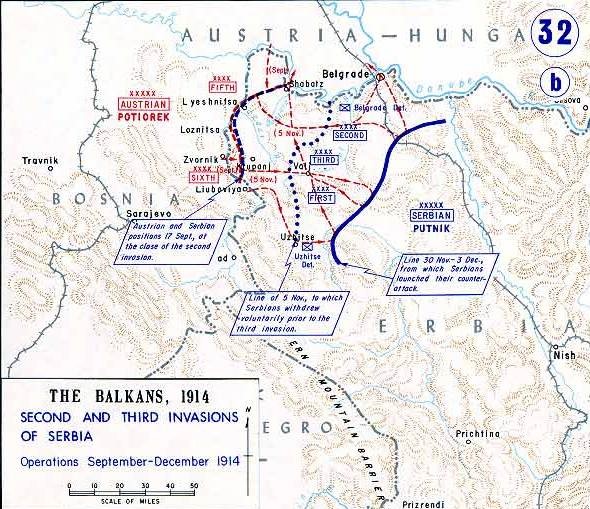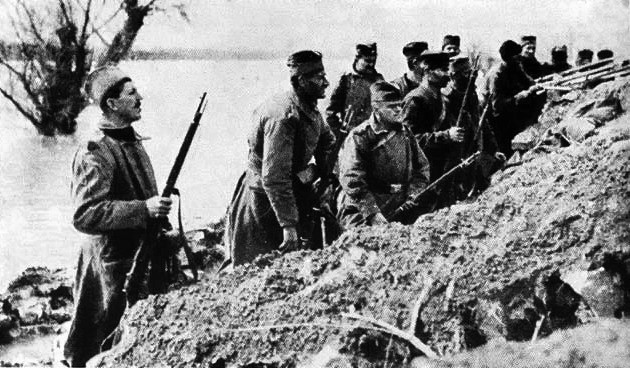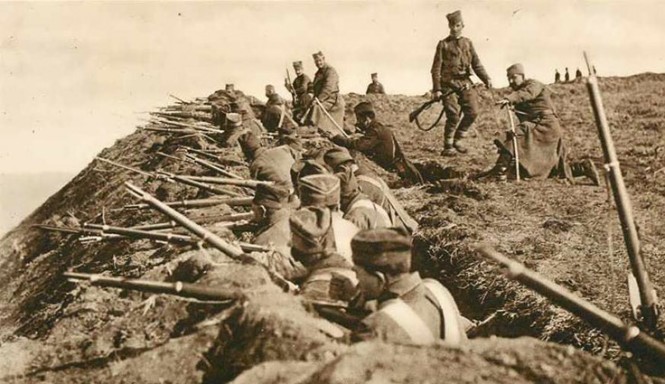
On the 16th November 1914 the battle of Kolubara began when the Austro-Hungarian armies, under the command of Oskar Potiorek, reached the Kolubara River during their third invasion of Serbia in 1914, after capturing the town of Vaijevo.
The Austro-Hungarians reached the Kolubara River on the 16th November and launched an assault against the Serbian defensive positions there. The Serbs managed to force the Austro-Hungarians back and over the next five days they fought a series of battles suffering heavy casualties in heavy rain and snowfall, resulting in many soldiers succumbing to frostbite or hypothermia.

During the night of the 18th November the Austro-Hungarians moved into position to carry out a further assault which began the following morning. The Austro-Hungarian’s main goal was to break through the defences of the Serbian army in order to drive them back towards the town of Gornji Milanovac, so they could capture the strategic town of Lazarevac. This town’s capture would give the Austro-Hungarian’s access to the Mladenovac railroad and an ability to outflank the Serbian forces guarding the road to Belgrade.

The Austro-Hungarian’s managed to capture the village of Vrace Brdo by the evening of the 19th November and seized the higher ground from the Serbs in the South. The Serbian army was forced to retreat giving the Austro-Hungarian’s the ability to advance deeper into Serbia. By the 24th November the Austrian commander Potiorek predicted that Serbia would be defeated within a matter of days.
Although the Serbian Army had put up fierce residence and inflicted heavy casualties on the Austro-Hungarians, the Serbian commander Putnik became concerned that his lines were over extended and began to plan for another strategic retreat, one which would include the evacuation of Belgrade. On the 29th November 1914 the Serbian Supreme Command decided to abandon the capital Belgrade. On the 1st December the Austro-Hungarian’s entered the city prompting celebrations in Vienna. They now believed that their war with Serbia would soon be over and began preparing for the countries occupation.

After the capture of Belgrade, it became increasingly clear to both Potiorek and Putnik that the Austro-Hungarian supply lines were over extended, so on December 1st Potiorek ordered the advancing 6th Army to wait for the 5th army to secure the supply lines resulting in a pause of all Austro-Hungarian operations. The Serbians exploited this respite and withdrew the 1st Serbian army from the front line allowing his soldiers time to rest. The Serbian’s then converged around Mount Rudnik where it received its long promised supplies from its allies. After he and his forces had rested and were resupplied, Putnik’s confidence in his forces ability to counterattack returned.
On December 2nd 1914 Putnik ordered an attack on the Austro-Hungarian front line and told his officers that the offensive was solely for the purpose of raising Serbian morale. Determined to play his part, the Serbian king Peter I also took a rifle and accompanied his troops to the front. The attack caught the Austro-Hungarian’s completely by surprise who were at the time holding a military parade through the streets of Belgrade. The Austro-Hungarian’s had not prepared a defence for a Serbian counter attack as their artillery was positioned far behind the front line and could not be used in the defence. By the night of December 2nd the Serbian’s had advanced far into Austro-Hungarian lines inflicting heavy casualties and taking many prisoners. The offensive’s initial success served to greatly enhance the morale of Serbian troops, just as Putnik had wanted. Significantly weakened, the Austro-Hungarians did not have time to recover before the offensive resumed the following morning and they were forced into retreat by the end of the day abandoning their weapons and equipment as they fled.

The Serbs anticipated that their opponents would entrench themselves and attempt to block the Serbian Army’s advance, but the Austro-Hungarians had failed to construct any defensive networks and were in no position to block the Serbian offensive. Their lack of prior preparation meant that the surrounding hills were devoid of any significant defensive positions. The Serbs exploited this weakness by maneuvering around the hills and encircling the Austro-Hungarians, suffering minimal casualties while breaking through.
By the 9th December the Austro-Hungarian counter attack lost all momentum and began to retreat to the city center. On the 10th December the Serbian’s captured the lower reaches of the Drina forcing the surviving Austro-Hungarian forces back across the river. By the 13th December the Austro-Hungarian’s in Belgrade could not hold the city for much longer and were ordered to withdraw from the city. On the 15th December the Serbian Army re-entered Belgrade and was in full control again by the following day.